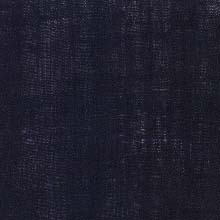Dye (p. 46 )
1. Produced in Kurikoma City, Miyagi Prefecture.
2. Characteristics: Hemp cloth dyed with indigo which is fermented at a normal temperature in early summer. The method is called "Hiyashi Zome" (cold dyeing ) and the simplest way to dye as additional heating is not applied. In "Shoai Zome ", all the stages of labor of hemp planting, indigo sowing, spinning, weaving and dyeing are all processed independently without relying on others for any part of it.
3. History: The "Hiyashi Zome" technique is said to be originated in the Nara Period. The Federal Government of the Date Family encouraged the planting of indigo in the Edo Period. As the farmers were forbidden to wear silk garments and the climate was not good for cotton planting, they planted hemp. Hemp weaving and indigo dyeing were exclusively engaged by women and the technique was handed down through generations. In 1955, Ayano Chiba was designated as the holder of the "Important Intangible Cultural Property".
Dyeing Method
1. Hemp seeds are sown in April and it harvests in late July or early August. Spinning and weaving are done in winter.
2. Indigo
Seeds are sown in rice nursery in the middle of April. When ripened, the indigo is reaped in early July and in August. The leaves of indigo are taken off from the stems just after they are reaped and they are dried in the sun. The dried leaves are scrubbed with the hands. After this process is repeated 2 or 3 times, they are put into straw bags for keeping. In Feburuary the indigo leaves are cleaned with water and piled up on the "Aidoko" (indigo bed)of straw mat which is put over rice chaff and rice straw. A straw mat and rice straw are put over the indigo leaves. They get fermented and heated in 3 or 4 days. They are watered and put upside down every 1 or 2 weeks. The process is repeated until the leaves have no more heat. Then they are left untouched until April. In April, the indigo leaves are taken out of the bed and put in a mortar to be beaten. The beaten indigo leaves are made into balls 10 centimeter in diameter called "Aidama" and are dried.After drying, the balls are broken into lumps with the size of chestnuts and stored . The indigo lump and burnt charcoal ash are put together in a wood tub in water 35 degrees centigrade. Water is added every day for a week. When foam is formed in the tub after a week, all of it is blended until the color of the foam becomes dark purple. This is how the "Aijiru" is processed and it is called "Aidate"(indigo dye making).
3. Dyeing
Hemp cloths are boiled and then bleached in water. Then the process is repeated 3 times- soaking the cloths in the "Aijiru"(indigo dye) for half an hour and then drying them to get the color. The dyed cloths are cleaned in water and treated with soy-bean juice "Gojiru" and dried in the shade.



